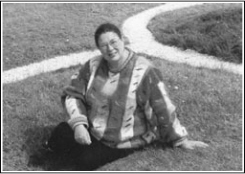White Horse Talisman (22 page)

“Magic friends,” said Chantel, stroking the White Horse's neck.
“Magic adventures,” added Owen.
“A summer of magic,” breathed Holly.
“Will that be time enough?” Myrddin whispered to Ava.
“Traa dy liooar? We must hope it will,” replied Ava.
“Your night is slipping away. I must return you,” said Equus. “The journey is long so sleep and dream, sleep and dream. Ahead are your new tomorrows.”
He and the Red Mare leapt for the wind.
“Watch for the star messages,” called Ava.
“We will.” The children waved back.
“Then farewell. We will meet again.”

A
UTHOR'S
N
OTE
Though
The White Horse Talisman
is a fantasy, it was inspired by a real English landscape. As a child growing up in England, I was fascinated by pictures of the three-thousand-year-old carving of the Uffington White Horse and always wondered who carved it and why. When I was ten I read
Sun Horse, Moon Horse
by Rosemary Sutcliffe and vowed that one day I would see the carved horse for myself. It never happened, and I grew up and emigrated to Canada. Five years ago, my husband decided it was time my dream was fufilled. He organized a visit to Uffington. The horse was beautiful. We marveled at its flowing shape and massive size, and both of us circled the eye seven times. (I won't tell you what I wished for.) We were intrigued to discover that the Great White Horse wasn't the only wonder in the area. It was surrounded by other fascinating ancient sites.
My husband discovered the Blowing Stone Inn, so we stayed there, found the Blowing Stone and blew it. We walked the Ridgeway track, explored the ditches and ramparts of Uffington Castle and climbed Dragon Hill, where tradition says St. George slew the dragon. It really is bald on top! One evening we hiked to Wayland's Smithy and entered the beech-tree circle at sunset. The magic of the place curled around me. As I stooped to crawl under the lintel stone, I saw a silver coin, an offering to Wayland, tucked in a crack. I knew then I had to write about everything I'd seen.
The story research led me on a fascinating journey through books on Celts and Saxons, paintings of saints, dragons and white horses, folksongs and folktales, children's rhymes, and other folklore. The description of the ritual scouring and the Pastime is based on the work of writer Thomas Hughes, who lived in Uffinâgton and recorded the customs of White Horse Vale in his book
The Scouring of the White Horse
. I've stayed true to the scouring except for one detail. I needed to link the Red Mare and White Horse, so I invented the role of the eye maker and the bucket of chalk that was carried to the the Red Mare. I grieve for the lost Red Horses of Tysoe. They were ploughed over by an angry landâowner in the 1800s. Their ghostly images were last seen through crop marks and aerial photos in 1968. They are now irretrievably grown over â except in stories!
As a child, I chanted the magpie rhyme many times. It's one of the oldest rhymes in the English language. The number seven is a “magic number” in many cultures, including those of the British Isles. The wealth of folkloric material and ancient sites inspired me so thoroughly that this story became not one fantasy but the first of four. You will be able to follow Chantel and Adam, Holly and Owen through the United Kingdom's mystical landscape in three more volumes of the Summer of Magic Quartet.
Andrea Spalding
August 2001

Award-winning author Andrea Spalding has written many popular books for children, including juvenile novels
Finders Keepers
and
An Island of My Own
, Young Readers
Phoebe and the Gypsy
and
The Keeper and the Crows
and picture books
Sarah May and the
New Red Dress
,
Me and Mr. Mah
and
It's Raining, It's Pouring
. An accomplished storyteller, Andrea hails from England, where she was long steeped in ancient lore, lore that now finds its full expression in the first volume of the Summer of Magic Quartet. She now lives with her husband on Pender Island, BC.